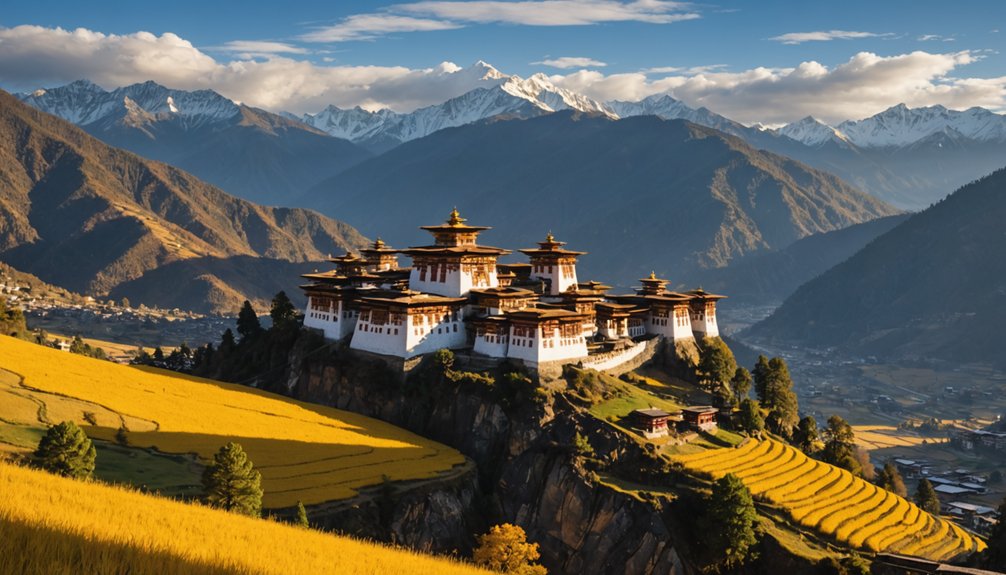You’ll find the best time to visit Bhutan during spring (March to May) and autumn (September to November). Spring brings blooming rhododendrons and clear Himalayan views, while autumn dazzles with vibrant tshechus featuring mesmerizing mask dances and fire ceremonies. Both seasons offer comfortable temperatures perfect for exploring ancient monasteries and mountain trails. In October, you can witness the Royal Highland Festival and the arrival of black-necked cranes. The kingdom’s seasonal treasures extend far beyond these peak months.
Key Takeaways
- Spring (March-May) offers clear Himalayan views, blooming rhododendrons, and comfortable temperatures, making it the prime season for visitors.
- October-November features major cultural festivals, comfortable weather, and the arrival of black-necked cranes.
- Winter (December-February) provides unique experiences with snow-covered landscapes and special festivals like Druk Wangyel Tsechu.
- Monsoon season (June-August) offers lower prices and fewer tourists, but expect regular rainfall and limited mountain views.
- September-November is ideal for trekking with stable weather, clear skies, and numerous cultural festivals across Bhutan.
Peak Season Magic: March to May
When spring awakens in Bhutan from March to May, you’ll discover the kingdom at its most alluring. As rhododendrons paint the hillsides in vibrant hues and clear skies reveal snow-capped Himalayan peaks, you’re perfectly positioned to experience the country’s cultural diversity through its most celebrated festivals.
Low humidity levels during this season ensure comfortable sightseeing conditions throughout your journey. You’ll find ideal conditions for both cultural immersion and outdoor adventure. Join locals at the magnificent Paro Tsechu, where masked dancers whirl in centuries-old traditions, or trek the legendary Jhomolhari Loop under comfortable temperatures ranging from 15-29°C. The kingdom’s commitment to sustainable tourism means you’ll share these experiences with limited fellow travelers, creating more authentic connections with local communities.
Whether you’re wandering through Punakha’s subtropical valleys or witnessing dawn break over Thimphu’s monasteries, spring’s moderate rainfall and rising temperatures create perfect conditions for exploring this mystical kingdom. Pack layers, book early, and prepare for Bhutan’s most alluring season.
Festival-Rich Autumn Months
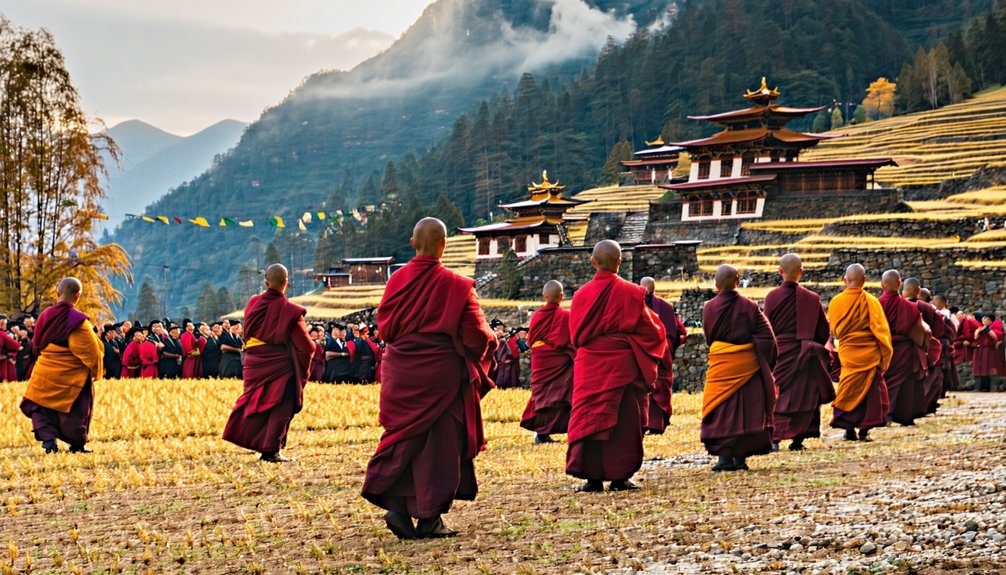
You’ll find Bhutan’s autumn calendar bursting with vibrant tshechus, from the grand mask dances of Thimphu Festival to the mystical fire ceremonies of Jambay Lhakhang Drup. The crisp October air and golden light create perfect conditions for photographing the swirling dancers and dramatic thongdrel disclosures against monastery backdrops. Between festivals, you can witness black-necked cranes arriving in Phobjikha Valley and explore dzongs under clear blue skies that characterize this culturally rich season. With 25 degrees Celsius during daytime hours, autumn provides comfortable temperatures for exploring the country’s cultural treasures.
Cultural Richness in October
As crisp autumn air sweeps across Bhutan’s valleys, October emerges as a culturally significant month packed with unique festivals and sacred rituals. You’ll discover the Royal Highland Festival in Laya, where yak races and traditional games showcase the rich mountain culture. Conservation takes center stage at the Black-necked Crane Festival in Gangtey, celebrating the arrival of these majestic birds.
In Bumthang’s Chhoekhor Gewog, the Thangbi Mani Festival features ancient fire blessing rituals where locals leap over purifying flames. At the Jhomolhari Mountain Festival, you’ll witness the perfect blend of cultural preservation and environmental awareness through traditional performances and sustainable tourism practices. The Tamzhing Phala Choepa adds spiritual depth with its mesmerizing Buddhist dances and ceremonies, offering a glimpse into Bhutan’s sacred traditions. The Wangdue Phodrang Tshechu provides visitors with four days of spectacular cultural celebrations from October 5th to 8th.
Major Tsechu Events
Throughout Bhutan’s vibrant autumn months, the country’s most spectacular Tsechu festivals transform ancient dzong courtyards into theatrical stages of sacred Buddhist tradition. You’ll witness mesmerizing masked dances at Thimphu Tshechu, the nation’s largest celebration, where monks in silk costumes bring ancient parables to life. In Bumthang Valley, Jakar Tshechu‘s mystical black hat dance unfolds against a backdrop of mountain peaks. Local farmers and villagers leave their fields to attend these sacred festivals in their finest traditional dress.
Festival planning requires careful timing, as dates shift annually with the lunar calendar. You’ll need to arrange transportation logistics well in advance, especially for remote venues like Prakhar Lhakhang. Dawn ceremonies, including the powerful thongdrol disclosures, draw massive crowds, so arrive early. Pack modest clothing and respect photography restrictions during sacred moments. For the ultimate freedom to explore, combine festival visits with autumn treks under crystal-clear skies.
Autumn Photography Opportunities
Autumn’s crisp air and pristine skies transform Bhutan into a photographer’s paradise during the festival season. You’ll find perfect temperatures between 10-20°C and stable weather conditions that make capturing Bhutan’s majestic landscapes a dream.
For long lens photography enthusiasts, the Phobjikha Valley offers incredible wildlife tracking opportunities as black-necked cranes arrive from late October. You’ll need a 300mm+ telephoto to capture their graceful mating dances. Meanwhile, the golden rice terraces of Paro and Punakha valleys create stunning backdrops, especially during early morning shoots when fog adds mystery to your compositions.
Don’t miss the chance to photograph monks rehearsing traditional mask dances at dzongs, or capture authentic moments at local archery competitions. The vibrant festivals draw visitors from September through November, offering unique opportunities to document centuries-old traditions. Just remember to pack polarizing filters and extra batteries for those chilly morning sessions.
Weather Patterns Across Bhutan’s Regions
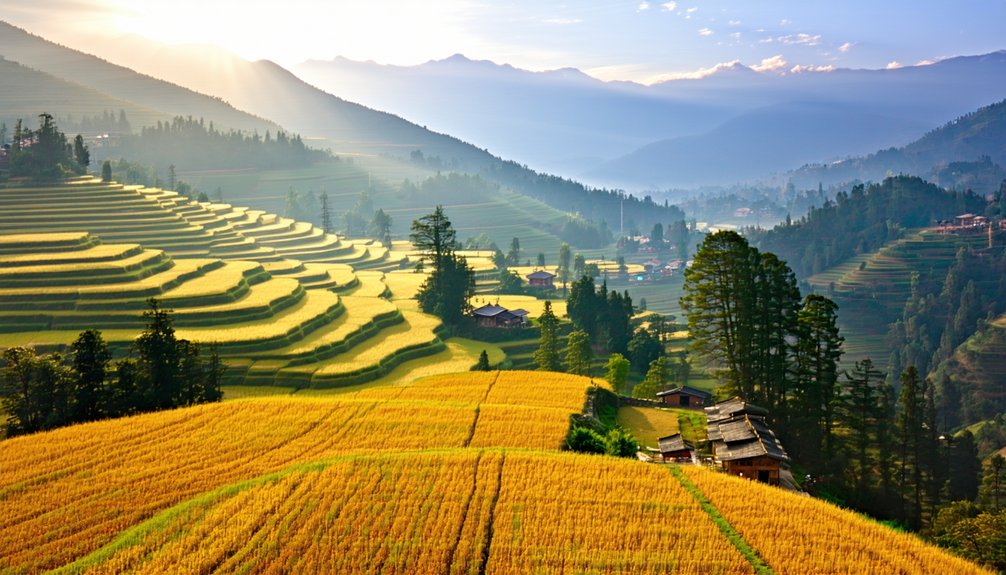
Bhutan’s dramatic topography creates three distinct climate zones that’ll shape your travel experience – from the steamy subtropical foothills in the south to the temperate central valleys and the crisp alpine highlands in the north.
In the southern foothills, you’ll encounter intense monsoon patterns with rainfall exceeding 2000mm annually. Summers are hot and humid, hitting 35°C, while winters remain mild at 15-20°C. These areas feature vibrant spring flora during March through May. The central valleys offer more moderate conditions at 1,200-3,000 meters elevation, where seasonal temperature ranges swing from pleasant summers around 25°C to cool winters between 0-10°C.
Venture into the northern highlands above 3,000 meters, and you’ll find yourself in an alpine wonderland. Summer days reach just 15°C, while winter temperatures plunge below -10°C. The mighty Himalayas block monsoon clouds here, creating a stark contrast to the south’s drenching rains – you’ll experience less than 500mm annual precipitation in these high-altitude zones.
Cultural Celebrations and Religious Events
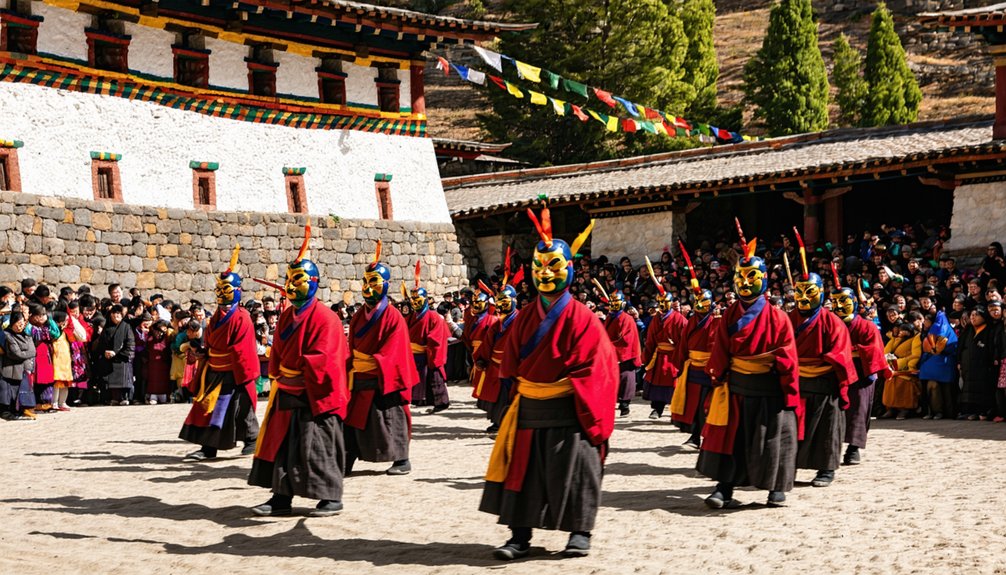
When planning your visit to the Land of the Thunder Dragon, you’ll discover that religious festivals known as tshechus serve as the cornerstone of Bhutanese cultural life. These celebrations showcase Bhutan’s rich cultural diversity through masked dances, ancient rituals, and sacred ceremonies.
| Season | Festival Highlight | Unique Feature |
|---|---|---|
| Spring | Paro Tshechu | Thongdrel display |
| Spring | Punakha Drubchen | Battle reenactments |
| Autumn | Thimphu Tshechu | 10,000 daily visitors |
| Autumn | Jambay Lhakhang | Midnight fire rituals |
The seasonal rituals follow nature’s rhythm, with spring festivals like the Rhododendron Festival celebrating the land’s biodiversity amid blooming flowers. In autumn, unique events like the Black-Necked Crane Festival blend conservation with tradition. Most festivals are celebrated in Dzongs where devotees gather to experience the spiritual atmosphere. You’ll find the most vibrant celebrations between March-May and September-November, when the weather is ideal for outdoor gatherings and ceremonial performances.
Winter’s Hidden Treasures

You’ll discover Bhutan’s valleys transformed into pristine wonderlands during winter, with snow-draped peaks creating perfect backdrops for photography at iconic sites like Tiger’s Nest Monastery. The arrival of endangered black-necked cranes in Phobjikha Valley marks a special time when locals celebrate these sacred birds through traditional songs and dances. Your winter journey gains extra warmth through authentic experiences like hot stone baths and fireside gatherings, where you can share stories with locals while sipping butter tea in centuries-old farmhouses. With December to February being peak snowfall season, visitors can witness the magical transformation of ancient dzongs and monasteries under fresh blankets of snow.
Tranquil Snow-Covered Valley Views
During winter’s peaceful embrace, the snow-draped valleys of Bhutan transform into ethereal landscapes that’ll take your breath away. At Dochula Pass, you’ll discover 108 chortens emerging from frost-covered landscapes, while majestic Himalayan peaks like Gangkar Puensum create a stunning backdrop just 50 minutes from Thimphu.
For truly serene snowfall scenes, venture to Phobjikha Valley, where Lavala Pass sits pristinely at 3,300m. Here, you’ll find frozen lakes mirroring snow-covered hillsides with barely another soul in sight. The rare black-necked cranes grace the valley during winter months, adding to its mystical allure. The untouched winter wonderland of Dochula comes alive during the Druk Wangyel Tsechu festival on December 13, where cultural celebrations unfold against a canvas of white. Pull over at roadside viewpoints to capture the magic of frost-tipped pine forests in perfect solitude.
Black-Necked Crane Migration
The majestic black-necked cranes of Bhutan offer nature’s most spellbinding winter spectacle as they descend from Tibet’s frigid plateaus to the warmer valleys below. You’ll find these sacred birds, known as “Thrung Thrung Karmo,” gracefully circling Gangtey Monastery before settling into Phobjikha Valley from late October through mid-March. The valley’s high-altitude marsh ecosystem at 3,000 meters provides perfect wintering conditions for these magnificent birds.
To witness their natural crane feeding patterns, head to the RSPN Visitor Center‘s eco-hide at dawn or dusk, where you’ll observe these magnificent creatures foraging in barley fields. Thanks to extensive crane conservation efforts, including underground power lines and strict protection measures, over 600 birds now safely winter here annually. For an unforgettable experience, time your visit with the Black-necked Crane Festival on November 11, where cultural celebrations honor these revered “Birds of Heaven.”
Festival of Traditional Warmth
Winter’s embrace transforms Bhutan into a mesmerizing festival wonderland, where centuries-old traditions come alive against snow-dusted mountains. You’ll discover unparalleled cultural immersion opportunities at celebrations like Druk Wangyel Tshechu, where Royal Bhutan Army soldiers perform sacred masked dances at Dochula Pass.
Experience seasonal wellness rituals in traditional hot stone baths, while cozy lodges equipped with Bukhari stoves offer respite from the winter chill. The enchanting Black-necked Crane Festival draws nature enthusiasts to witness traditional performances celebrating these majestic birds. As temperatures dip to invigorating 10-15°C in the valleys, you’ll find yourself wandering through intimate winter markets filled with handcrafted textiles and woodwork. The season’s clear skies reward you with pristine views of Himalayan peaks, while fewer tourists mean you’ll have landmarks like Punakha Dzong nearly to yourself, creating perfect moments for photography and peaceful contemplation.
Monsoon Travel Opportunities
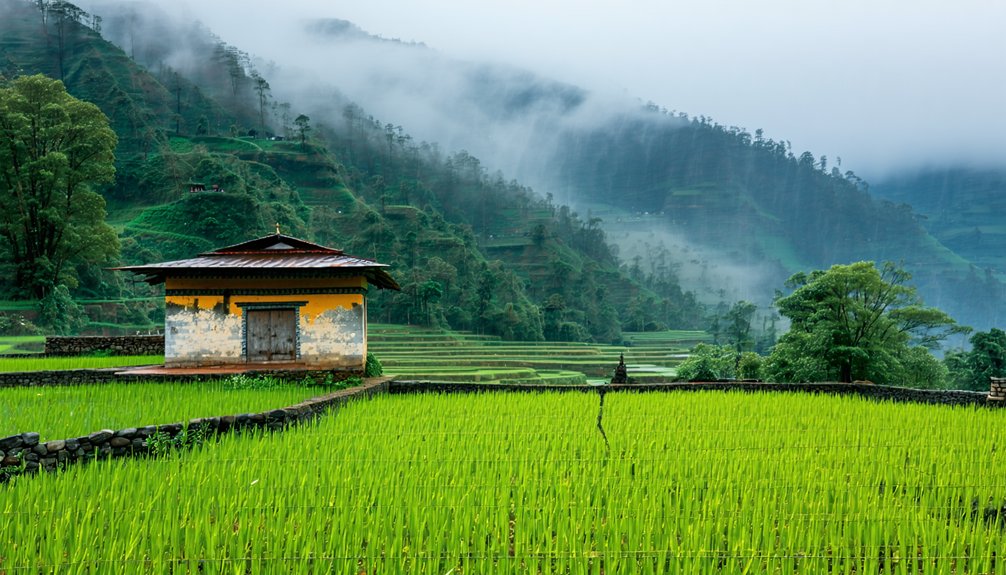
While monsoon season may deter some travelers from visiting Bhutan, savvy adventurers can discover unique opportunities between June and September. You’ll find pristine valleys draped in emerald hues, with fewer tourists crowding the sacred dzongs and monasteries. Embrace the freedom to explore traditional handicraft demonstrations or immerse yourself in rural homestay experiences while summer rains transform the landscape. The season offers excellent opportunities to join local experts for mushroom foraging expeditions and tastings of various native species.
| Experience | Benefit |
|---|---|
| Off-peak Travel | Up to 30% savings on accommodations |
| Cultural Immersion | Intimate monastery visits without crowds |
| Local Connection | One-on-one time with artisan teachers |
| Nature’s Show | Verdant valleys in full bloom |
Take advantage of the season’s unique charm by participating in indoor activities like traditional cooking classes or meditation sessions. You’ll discover that monsoon weather creates perfect conditions for authentic cultural exchanges, while morning explorations reward you with misty mountain views and peaceful temple visits before afternoon showers arrive.
Photography and Wildlife Viewing Times
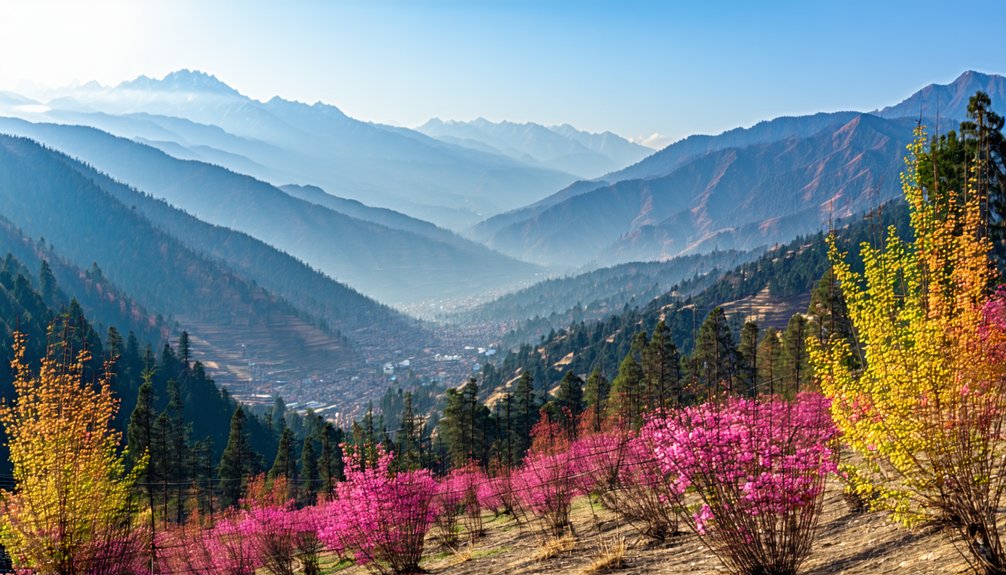
For photographers seeking Bhutan’s iconic shots, you’ll find autumn’s crystal-clear skies offer unparalleled mountain vistas, while spring brings vibrant rhododendron blooms and festivals bursting with color. You can capture remarkable wildlife moments throughout the year, from black-necked cranes in Phobjikha Valley during winter to rare white-bellied herons along riverbanks in spring and fall. The golden hours of dawn and dusk yield the most dramatic lighting for landscape photography, particularly at high-altitude locations like Jigme Dorji National Park, where snow leopards and blue sheep might grace your frame. Photographers should avoid late June to September as the monsoon season’s heavy rainfall makes wildlife viewing and outdoor photography challenging in most regions.
Peak Photography Light Opportunities
The most spectacular photography opportunities in Bhutan emerge during two distinct seasons – spring (March-May) and autumn (September-November). You’ll find the golden hour casting magical light over ancient dzongs and monasteries, particularly at Punakha Dzong during late afternoon when warm tones paint its white walls. The blooming Jacaranda trees create stunning purple backdrops for your photographs at Punakha Dzong in springtime.
For sunrise shoots, head to Bumthang Valley where misty landscapes create ethereal effects in temperatures perfect for your gear. At sunset, capture Buddha Dordenma in Thimphu bathed in golden light – you’ll want to keep your ISO between 100-400 for supreme dynamic range. On overcast days, don’t pack away your camera; the diffused light actually works in your favor, especially in forests where harsh shadows typically pose challenges. These conditions are ideal for capturing the intricate details of Bhutan’s abundant flora.
Wildlife Migration Viewing Seasons
Throughout Bhutan’s distinct seasons, wildlife enthusiasts can catch nature’s most spectacular shows during key migration periods. You’ll witness endemic species migrations like the majestic Black-necked Cranes arriving in Phobjikha Valley during late autumn, with populations peaking in winter. Just as rainfall patterns affect wildlife movements globally, Bhutan’s seasonal precipitation influences the timing and routes of animal migrations.
| Season | Key Wildlife Activity |
|---|---|
| Autumn | Migratory birds from Tibet/Mongolia |
| Winter | Peak Black-necked Crane viewing |
| Spring | Endemic breeding birds/Ward’s Trogon |
| Summer | Wetland species/amphibian activity |
| Late Autumn | Crane courtship displays |
Seasonal wildlife activity varies dramatically throughout the year. Trek through temperate forests in autumn to spot Blood Pheasants, explore winter’s crisp valleys for Ibisbill sightings, or watch Satyr Tragopan’s spring breeding displays. While summer monsoons limit high-altitude adventures, they create perfect conditions for discovering subtropical forest biodiversity in places like Royal Manas National Park.
Mountain Vista Photography Timing
Stunning mountain vistas await photographers during Bhutan’s prime shooting seasons, with autumn (September-November) offering crystal-clear Himalayan panoramas and spring (March-May) presenting a canvas of rhododendron blooms against snow-capped peaks.
You’ll find the best light for capturing village life during autumn’s golden hours, when farmers harvest rice against a backdrop of pristine mountain views. Scenic vistas abound throughout Bhutan’s diverse terrain, offering countless opportunities for breathtaking shots. This season’s clear skies and moderate temperatures create perfect conditions for early morning shoots at iconic locations like Tiger’s Nest. In spring, you’ll encounter agrarian festivals that add vibrant cultural elements to your mountain photography. For the sharpest mountain shots, plan your outings during the early morning hours before clouds roll in. Winter (December-February) offers crisp visibility and snow-dusted landscapes, though you’ll need to brave the cold.
Budget-Friendly Travel Periods
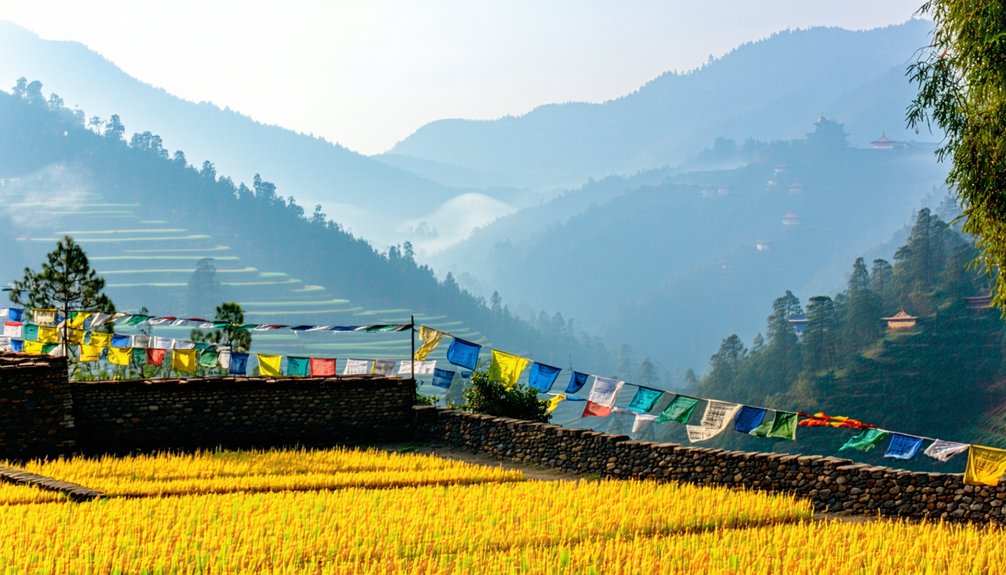
While many travelers focus on peak seasons, savvy visitors can experience Bhutan’s magic at a fraction of the cost during specific periods throughout the year. You’ll find substantial seasonal flight discounts and accommodation bargains during December through February and June through August, with rates dropping 20-30% below peak prices.
The winter months offer crystal-clear skies perfect for photography, though you’ll need to pack for cold weather. Your trip will benefit from the minimum daily package rates being lower during these off-peak times. If you’re heading to southern Bhutan, the subtropical climate remains inviting year-round. For cultural immersion without the crowds, consider timing your visit with lesser-known festivals like Punakha Drubchen in February-March, where you’ll avoid the premium pricing of major celebrations.
Western and central valleys stay accessible during summer months, with pleasant temperatures around 20-25°C and light rainfall. For the best value, combine off-season travel with local festivals, and don’t hesitate to negotiate your accommodation rates – they’re often flexible during these quieter periods.
Trekking and Adventure Seasons
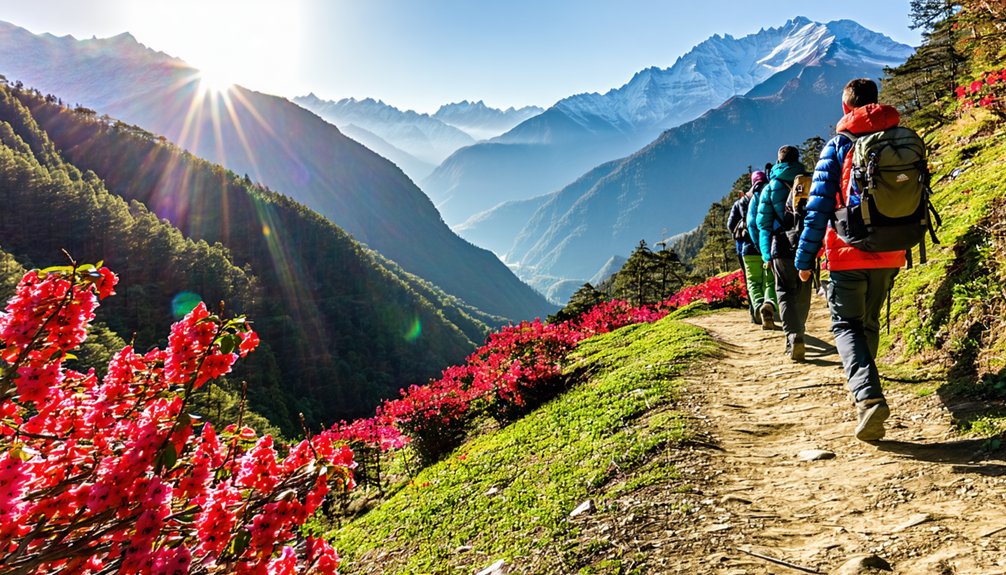
Adventure seekers flock to Bhutan’s trails during two prime trekking windows: autumn (October-November) and spring (March-May). You’ll experience stable weather, clear mountain views, and perfect hiking temperatures during these seasons. While early autumn weather patterns might bring some lingering rain in September, by October, you’re rewarded with crisp, clear skies and unobstructed Himalayan vistas. Daily temperatures range from 29°C down to below freezing during autumn treks.
The best times to trek Bhutan’s majestic trails are autumn and spring, offering ideal conditions and breathtaking Himalayan panoramas.
If you’re new to high-altitude hiking, consider lower altitude trekking routes in winter when temperatures remain manageable below 3,000 meters. Just avoid the monsoon season (June to mid-September) when trails become treacherous.
- Witness stunning rhododendron blooms along spring trails
- Combine your trek with vibrant cultural festivals in autumn
- Experience traditional village life in the Bumthang Valley year-round
- Navigate snow-free passes on the legendary Snowman Trek in October
Choose your trekking season based on your preferred route’s altitude and your comfort with varying weather conditions. Each season offers unique perspectives on Bhutan’s natural and cultural landscape.
Valley-Specific Climate Guide
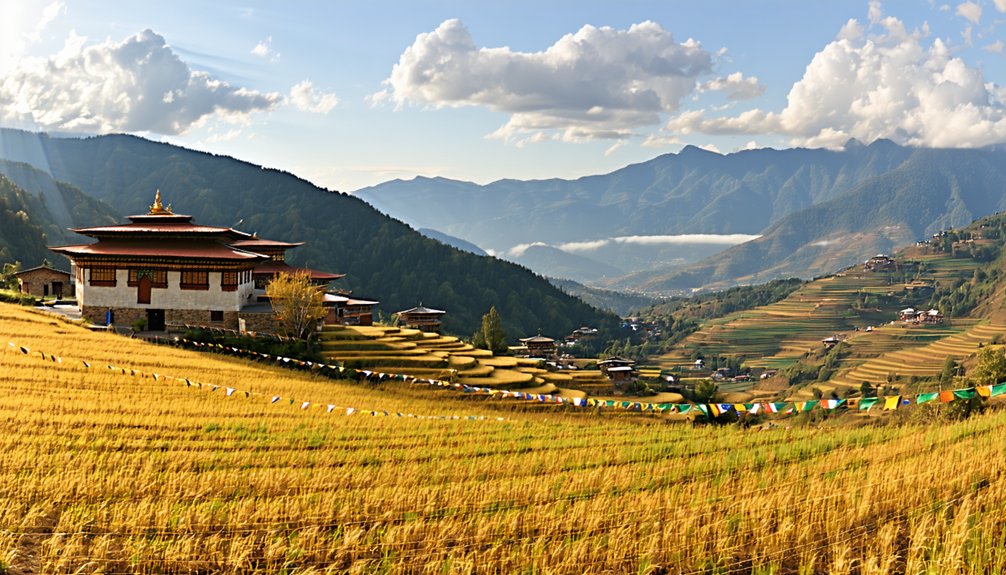
Each of Bhutan’s major valleys offers its own distinct microclimate, shaped by dramatic elevation changes and unique geographical features. You’ll experience vastly different conditions as you travel between these diverse regions, with valley specific rainfall patterns influencing your journey.
In Paro and Thimphu (2,200-2,800m), you’ll find moderate temperatures ideal for exploring dzongs and markets. Punakha’s lower elevation (1,200-1,800m) creates a subtropical paradise, perfect for winter escapes when higher regions chill. The valley specific tourism infrastructure adapts to these climate variations, with Bumthang’s high-altitude location (2,600-4,000m) offering alpine adventures and cultural festivals in spring and fall. The monsoon rains are heaviest in the western valleys, creating lush landscapes during the summer months.
For a truly unique experience, time your visit to Gangtey Valley (3,000m) during winter to witness black-necked cranes against snow-dusted landscapes, or explore summer’s wildflower meadows. Each valley’s distinct seasonal rhythms create opportunities for immersive cultural experiences throughout the year.

